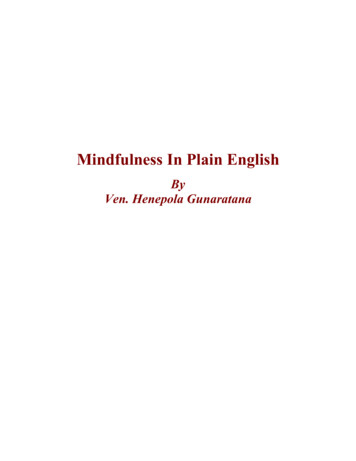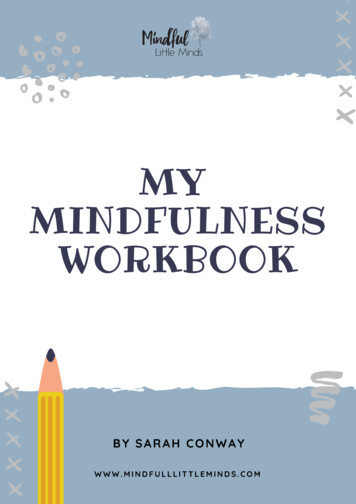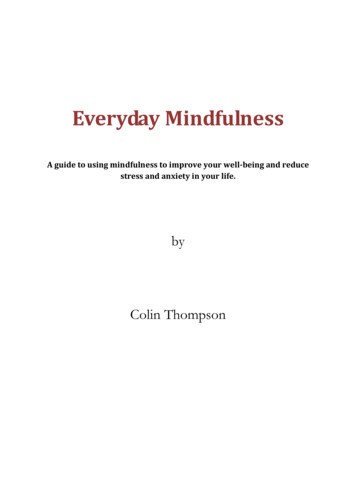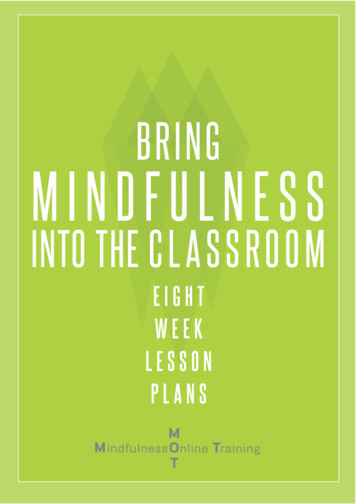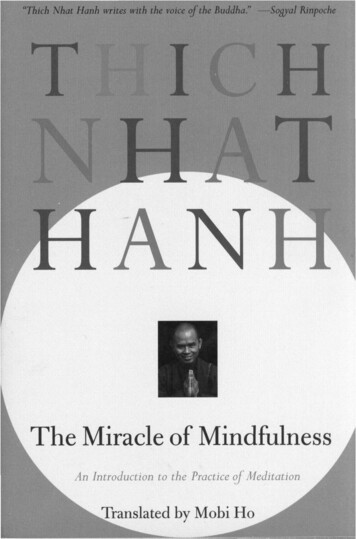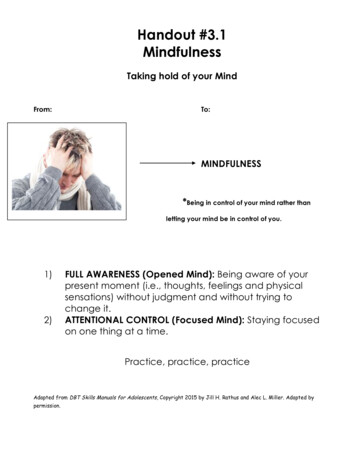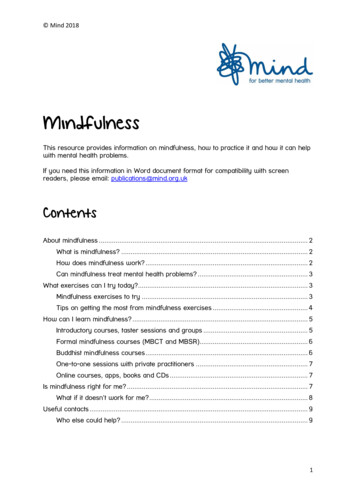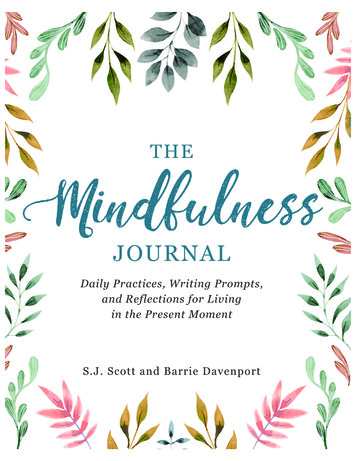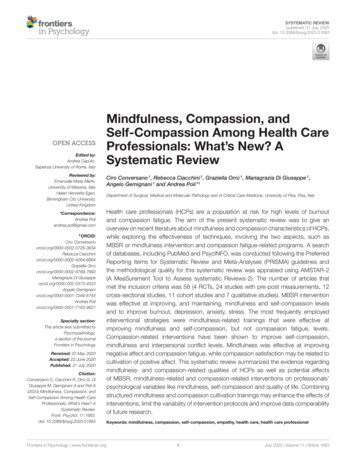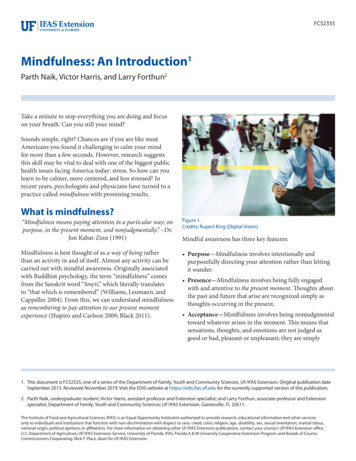
Transcription
FCS2335Mindfulness: An Introduction1Parth Naik, Victor Harris, and Larry Forthun2Take a minute to stop everything you are doing and focuson your breath. Can you still your mind?Sounds simple, right? Chances are if you are like mostAmericans you found it challenging to calm your mindfor more than a few seconds. However, research suggeststhis skill may be vital to deal with one of the biggest publichealth issues facing America today: stress. So how can youlearn to be calmer, more centered, and less stressed? Inrecent years, psychologists and physicians have turned to apractice called mindfulness with promising results.What is mindfulness?“Mindfulness means paying attention in a particular way; onpurpose, in the present moment, and nonjudgmentally.” –Dr.Jon Kabat-Zinn (1991)Figure 1.Credits: Rupert King (Digital Vision)Mindfulness is best thought of as a way of being ratherthan an activity in and of itself. Almost any activity can becarried out with mindful awareness. Originally associatedwith Buddhist psychology, the term “mindfulness” comesfrom the Sanskrit word “Smŗti,” which literally translatesto “that which is remembered” (Williams, Leumann, andCappeller 2004). From this, we can understand mindfulnessas remembering to pay attention to our present momentexperience (Shapiro and Carlson 2009; Black 2011). Purpose—Mindfulness involves intentionally andpurposefully directing your attention rather than lettingit wander.Mindful awareness has three key features: Presence—Mindfulness involves being fully engagedwith and attentive to the present moment. Thoughts aboutthe past and future that arise are recognized simply asthoughts occurring in the present. Acceptance—Mindfulness involves being nonjudgmentaltoward whatever arises in the moment. This means thatsensations, thoughts, and emotions are not judged asgood or bad, pleasant or unpleasant; they are simply1. This document is FCS2335, one of a series of the Department of Family, Youth and Community Sciences, UF/IFAS Extension. Original publication dateSeptember 2013. Reviewed November 2019. Visit the EDIS website at https://edis.ifas.ufl.edu for the currently supported version of this publication.2. Parth Naik, undergraduate student; Victor Harris, assistant professor and Extension specialist; and Larry Forthun, associate professor and Extensionspecialist; Department of Family, Youth and Community Sciences; UF/IFAS Extension, Gainesville, FL 32611.The Institute of Food and Agricultural Sciences (IFAS) is an Equal Opportunity Institution authorized to provide research, educational information and other servicesonly to individuals and institutions that function with non-discrimination with respect to race, creed, color, religion, age, disability, sex, sexual orientation, marital status,national origin, political opinions or affiliations. For more information on obtaining other UF/IFAS Extension publications, contact your county’s UF/IFAS Extension office.U.S. Department of Agriculture, UF/IFAS Extension Service, University of Florida, IFAS, Florida A & M University Cooperative Extension Program, and Boards of CountyCommissioners Cooperating. Nick T. Place, dean for UF/IFAS Extension.
noticed as “happening,” and observed until they eventually pass.Research into mindfulness and its applications hasincreased exponentially over the past two decades.Although originally a Buddhist concept, mindfulness isnow understood to be an inherent quality of consciousnessthat can be measured empirically and scientifically (Kohls,Sauer, and Walach 2009; Black 2010). It is also understoodthat mindfulness requires no religious, ethical, spiritual, orideological commitments to practice (Walach et al. 2007).The scientific interest in mindfulness has been largelycredited to the work of Dr. Jon Kabat-Zinn, founder ofthe University of Massachusetts Medical School StressReduction Clinic. Kabat-Zinn, an MIT-trained molecularbiologist, began researching mind-body medicine in themid-1970s, focusing on the clinical application of mindfulness meditation for individuals afflicted with chronic painand stress-related illnesses (Kabat-Zinn 2005; Kabat-Zinn1991). From this research, he developed the MindfulnessBased Stress Reduction (MBSR) curriculum, an eight-weektraining course that has been successfully used with a wideaudience, from cancer patients to those suffering fromdepression to highly stressed business executives (Grossman, Niemann, Schmidt, and Walach 2004; Walach et al.2007).stressed and said or did things we didn’t mean. In thesemoments, we may have felt we had no control over ourwords or actions—as if we were reacting to situationswithout thinking.If you experience a moment like this, mindfulness can helpin several ways. First, being mindful can help you becomemore aware of your emotions before they escalate andcontrol you. Instead of recognizing your anger only afteryou lash out at someone, you can catch your anger whenit is still mild and take steps to diffuse it. Furthermore,mindfulness can help you look at your thoughts andemotions with more objectivity. Instead of letting minorevents trigger negative thinking, mindfulness lets you takea step back to recognize you are feeling stressed or anxiousand this anxiety may be influencing your thoughts.More than 200 major medical centers across the UnitedStates now implement MBSR, and many adaptations ofmindfulness-based therapies have followed, includingMindfulness-Based Cognitive Therapy (Teasdale et al.2000).Benefits of MindfulnessMindfulness is a mind-body practice that has been found tobenefit both psychological and physical health. The primarypsychological change that occurs during mindfulnesspractice is an increased awareness of thoughts, feelings, andsensations in the present moment. Over time mindfulnesspractice can help you to become aware of the space betweennoticing experiences and reacting to them by letting youslow down and observe the processes of your mind (Black2010). The ultimate goal of mindfulness practice is foryou to take advantage of this space so you can make moreintentional decisions—to wake up from living life onautopilot, based on unproductive habits of mind (Black2010; Walach et al. 2007).It is easy to see how mindfulness could be beneficial indealing with stress or other difficult emotions. For example,we have all been in situations where we became angry orMindfulness: An IntroductionFigure 2.Credits: iStockphotoSo how can mindfulness help you respond to your emotionsafter you have recognized them? Problems with regulatingemotions fall into two categories, either repression or excessive reactivity. Instead of ignoring emotions completely oracting on every emotion impulsively, mindfulness providesa third option: “being with” emotions. By holding youremotions in mindful awareness, you can separate yourraw emotions and the accompanying sensations from thethoughts you have about them. This would be the differencebetween thinking about all the reasons you are upset andsimply recognizing you are upset. Being with your emotionsin this way lets you observe your emotions closely until2
they naturally pass, and it also lets you intentionally makedecisions about how to respond to the information youremotions provide.According to the American Psychological Association,some empirically supported benefits of mindfulness includethe following (Davis & Hayes 2011):Psychological Benefits Increased awareness of one’s mind Significantly reduced stress, anxiety, and negativeemotions Increased control over ruminative thinking (a majorcause and symptom of depression and anxiety) Increased mental flexibility and focus More working memory Decreased distracting thoughts Decreased emotional reactivity Increased capacity for intentional, responsive behaviors Increased empathy, compassion, and conscientiousness ofother’s emotionsPhysiological Benefits Enhanced immune system functioning Increased brain density and neural integration in areasresponsible for positive emotions, self-regulation, andlong-term planning Lowered blood pressure Lowered levels of blood cortisol (a major stress hormone) Greater resistance to stress-related illnesses such asheart diseaseSpiritual Benefits Increased self-insight and self-acceptance Increased acceptance of others Increased compassion and empathy Increased sense of morality, intuition, and courage tochange Increased control over automatic behaviors Increased self-disciplineMindfulness: An IntroductionHow can you start practicingmindfulness?“Mindfulness is a habit, it’s something the more one does,the more likely one is to be in that mode with less and lesseffort it’s a skill that can be learned. It’s accessing somethingwe already have. Mindfulness isn’t difficult. What’s difficult isto remember to be Mindful.” –John Teasdale, co-originatorof MBCT (Rock 2009)With mindfulness practice, learning how to be mindful isonly the tip of the iceberg. The bulk of this practice is aboutfamiliarizing yourself with what it feels like to be mindful,and getting better at “remembering” to maintain mindfulawareness. This means that almost any activity can beturned into a mindfulness practice if it involves the following basic components:1. Direct involvement of one of your five senses—Focusing on one of your senses grounds you in the presentmoment. It also provides you with the opportunity toseparate the sensory experience from the thoughts youare having about it.2. An “anchor”—The anchor serves as the object of attention during mindfulness practice. For example, if you arebeing mindful of your breath, you should try to maintaina continual awareness of the physical sensation of yourbreath entering and leaving your body. This could meanfeeling the air entering and exiting your nostrils, or eventhe sensation of your lungs expanding and contracting.The exact sensation doesn’t matter as long as you cankeep focused on it. Some other common examples ofanchors are the sound of a bell, or the taste and texture offood. The range of possibilities is practically limitless, sofeel free to experiment.3. Returning to the anchor—This is where the power ofmindfulness practice comes from. Chances are you willonly be able to remain focused on your anchor for a fewmoments before becoming distracted. This is OK and tobe expected. When you realize you have lost focus, gentlyrefocus your attention on the anchor.With time and practice, your mind will begin to settle intocalmness and you will find yourself able to focus for longerperiods. While at first you may only notice yourself driftingfrom your anchor long after you start daydreaming, eventually you will start to notice distractions (such as thoughts orsensations) as they arise. Instead of being lured away fromyour anchor by these distractions, it will be easier to simplynotice them and let them pass. A helpful metaphor to keep3
in mind is that your distractions are like clouds passing inthe sky—notice them without judgment and then let thempass without a trace.focused, but gently returning your attention to your breathwhen you lose focus.Experiment with creating your own mindfulness practicesthroughout the day. Being mindful of the sensation onthe soles of your feet as you walk to your car or the tasteand texture of your morning coffee can transform routinemoments into deeply satisfying practices. However, havinga ritualized and structured practice can be beneficial. Beloware instructions for two common mindfulness practices.1. Posture—Stand straight and alert, but not rigidly so.Evenly distribute your weight between your feet. You canrelax your arms by your sides or hold them behind yourback if they are distracting. Take a moment to feel theweight of your body supported by the ground. Soften anddrop your gaze slightly if this helps you focus.Mindful Breathing (Formal Seated BreathMeditation)1. Posture—Assume a comfortable upright but relaxedsitting posture. There is no requirement to sit on the floor,and sitting in a chair is perfectly acceptable. The key is tochoose a posture that lets you be comfortable and alert.You can choose to keep your eyes open, but if you area beginner, it may be easier to keep your eyes closed toavoid distractions. If you choose to keep your eyes open,let your gaze rest softly a few feet in front of you on thefloor without focusing on a particular object.2. Getting grounded—Take a few moments to notice anytension you may be holding in your body. Relax your faceand jaw, and let your shoulders relax. Feel the weight ofyour body resting on the ground or in your chair.3. Notice your breath—Once you begin to feel groundedin your body, try to notice the sensation of your breath.Some sensations you could focus on include the air as itenters and leaves your nose, the expanding and contracting of your lungs, or the sound of the air in your throat.If you have difficulty feeling your breath, it may help toplace one hand on your belly so that you can feel it risingand falling as you breathe.Mindful Walking2. Choosing your path—If this is your first time tryingmindful walking, you may feel more comfortable if youchoose a short path (no longer than 100 feet) and walkback and forth on that path. As you become comfortablewith the practice, feel free to choose a more elaboratepath or even try walking mindfully as you go about yourday.3. Walking—As you take your first steps, focus your attention on the sensation of your weight shifting on the solesof your feet. If you are barefoot, try noticing the texturesof the ground. Maintain a steady rhythm as you walk; itmay also be useful to walk a bit slower than you usuallywould.4. Staying with the steps—As you fall into rhythm, keepyour attention focused on the sensations coming from thesoles of your feet. If you catch yourself drifting off, gentlyguide your attention back to your feet. Once again, themost important aspect of this practice is not how longyou stay focused, but rather noticing your mind wandering and then re
“Mindfulness means paying attention in a particular way; on purpose, in the present moment, and nonjudgmentally. . feel free to experiment. 3. Returning to the anchor —This is where the power of mindfulness practice comes from. Chances are you will only be able to remain focused on your anchor for a few moments before becoming distracted. This is OK and to be expected. When you realize .
